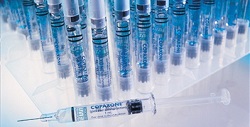 |
On Thursday, Momenta and Novartis' ($NVS) Sandoz launched their copy of Teva ($TEVA) blockbuster Copaxone after a U.S. court nixed the multiple sclerosis drug's patent for the second time. Industry watchers largely expected the move, Bernstein's Ronny Gal wrote in a note to clients. The real question? When Mylan ($MYL) will enter the market with its own copy.
Though Mylan has "argued passionately to us that they are close" to winning the FDA's favor, Gal says, the fact that it didn't take home simultaneous approval when the Momenta/Sandoz tandem got its green light in April suggests that "they are not approvable near term."
The FDA lab that analyzed Momenta's product likely analyzed Mylan's as well, he wrote. And Momenta has IP on methods of controlling Copaxone's manufacturing--something it may be able to enforce on Mylan.
Gal also pointed to the case of Sanofi's Lovenox, another complicated-to-make drug whose first generic came from the Momenta/Sandoz team. "In the Lovenox case it took two years for the next player to enter," he wrote.
All in all, he models a mid-2016 launch, though "only FDA knows the answer." If it does take that long, though, it won't be the end of the world for Mylan: Though its management has predicted their company would be there "at market formation," Gal hasn't modeled generic Copaxone as a big contributor to earnings.
And on the flip side, the delay helps Teva and the Momenta/Sandoz partnership, who will have less competition. A Mylan entry would have taken 30% of the market and "reduced the prevailing price another 10%," whittling down biosim Copaxone revenue to between $25 million and $30 million, Gal figures. Without Mylan's version, though, "it will likely have material, long-term impact on the Momenta/Sandoz market share in this generic market," he wrote, helping Momenta hit at the high end of its sales expectations.
Teva, meanwhile, has one rival to worry about instead of two--though it also has payers to consider. The Israeli drugmaker has switched more than two-thirds of Copaxone patients over to a longer-lasting, patent-protected version of the med in order to lock up market share, but now that cheaper versions are here, payers may not look so fondly on those tactics.
"Some payers are viewing this as Teva's strategy to avoid losing patients, and they may take an aggressive stance," consultant Gary Owens told Bloomberg in March. "It's going to be a wrestling match between two 500-pound gorillas."
Special Reports: Top 10 Drug Patent Losses of 2015 - Copaxone | Top 10 Generics Makers by 2012 Revenue - Teva - Novartis (Sandoz)